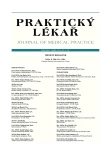Telomeres and the influence of lifestyle on their length
Authors:
I. Klimešová
Authors‘ workplace:
Fakulta tělesné kultury UP v Olomouci, Katedra přírodovědních věd v kinantropologii, Vedoucí: prof. RNDr. Miroslav Janura, PhD.
Published in:
Prakt. Lék. 2011; 91(12): 734-737
Category:
Of different specialties
Overview
Over the past 50 years scientists have made substantial progress in understanding the processes at the cellular and molecular levels. Yet many ongoing processes in the cell still remain unclear. Thanks to the unique properties of telomeres, end segments of chromosomes are at the forefront of research. Not all processes that take place in these structures have been explained, but they present possible potential to protect the cells against aging, as well as in the understanding and treatment of tumour growth.
Telomeres are the chromosomal ends to preserve DNA integrity and chromosomal stability. Shortening of telomere length induces cell damage. Human telomere length is influenced by both genetic and environmental factors and it is closely related to aging and the development of certain diseases.
The study summarizes the results of work focused on the impact of exercise and diet on the length of telomeres. These studies have shown that various forms of exercise and diet modify the length of telomeres.
Key words:
telomeres, exercise, nutrition.
Sources
1. Brouillette, S.W., Moore, J.S., McMahon, A.D. et al. Telomere length, risk of coronary heart disease, and statin treatment in the West of Scotland Primary Prevention Study: a nested case-control study. Lancet, 2007, 369, p. 107–114.
2. Cassidy, A., De Vivo, I., Liu, Y. et al. Associations between diet, lifestyle factors, and telomere length in women. Am. J. Clin. Nutr. 2010, 91, p. 1273–1280.
3. Cawthon, R.M., Smith, K.R., O’Brien, E. et al. Association between telomere length in blood and mortality in people aged 60 years or older. Lancet, 2003, 361, p. 393–395.
4. Cherkas, L.F., Hunkin, J.L., Kato, B.S. et al. The association between physical activity in leisure time and leukocyte telomere length. Arch. Intern. Med. 2008, 168, p. 154–158.
5. Collins, M., Renault, V., Grobler, L.A. et al. Athletes with exercise-associated fatigue have abnormally short muscle DNA telomeres. Med. Sci. Sports. Exerc. 2003, 35, p. 1524–1528.
6. Epel, E.S., Blackburn, E.H., Lin, J. et al. Accelerated telomere shortening in response to life stress. Proc. Natl. Acad. Sci. USA, 2004, 101, p. 17312–17315.
7. Farzaneh-Far, R., Lin, J., Epel, E.S. et al. Association of marine omega-3 fatty acid levels with telomeric aging in patients with coronary heart disease. JAMA, 2010, 303, p. 250–257.
8. Farzaneh-Far, R., Lin, J., Epel, E.S. et al. Telomere length trajectory and its determinants in persons with coronary artery disease: longitudinal findings from the heart and soul study. PLoS One 2010, No. 5, e 8612. Dostupný na WWW: http://www.plosone.org/article/info%3Adoi%2F10.1371%2Fjournal.pone.0008612.
9. Gardner, J.P., Li, S., Srinivasan, S.R. et al. Rise in insulin resistance is associated with escalated telomere attrition. Circulation 2005, 111, p. 2171–2177.
10. Hou, L., Savage, S.A., Blaser, M.J. et al. Telomere length in peripheral leukocyte DNA and gastric cancer risk. Cancer Epidemiol. Biomarkers Prev. 2009, 18, p. 3103–3109.
11. LaRocca, T.J., Seals, D.R., Pierce, G.L. Leukocyte telomere length is preserved with aging in endurance exercise-trained adults and related to maximal aerobic capacity. Mech. Ageing Dev. 2010, 131, p. 165–167.
12. Ludlow, A.T., Zimmerman, J.B., Witkowski, S. et al. Relationship between physical activity level, telomere length, and telomerase activity. Med. Sci. Sports Exerc. 2008, 40, p. 1764–1771.
13. Möller, P., Mayer, S., Mattfeldt, T. et al. Sex‐related differences in length and erosion dynamics of human telomeres favour females. Aging 2009, 1(8), p. 233–739.
14. Neidle, S., Parkinson, G.N. The structure of telomeric DNA. Curr. Opin .Struct. Biol. 2003, 13, p. 275–283.
15. Nieman, D.C. Immune response to heavy exertion. J. Appl. Physiol. 1997, 82, p. 1385–1394.
16. O’Callaghan, N.J., Clifton, P.M., Noakes, M., Fenech, M. Weight loss in obese men is associated with increased telomere length and decreased basic sites in rectal mucosa. Rejuvenation Res. 2009, 12, p. 169–176.
17. Olovnikov, A.M. Telomeres, telomerase, and aging: origin of the theory. Exp. Gerontol. 1996, 31, p. 443–448.
18. Ornish, D., Lin, J., Daubenmier, J. et al. Increased telomerase activity and comprehensive lifestyle changes: a pilot study. Lancet Oncol. 2008, 9, p. 1048–1057.
19. Samassekou, O., Gadji, M., Drouin, R., Yan, J. Sizing the ends: Normal length of human telomeres. Ann. Anat. 2010, 192, p. 284–291.
20. Shay, J.W., Wright, W.E. Hallmarks of telomeres in ageing research. J. Pathol. 2007, 211, p. 114–123.
21. Šenkeříková, M., Jüttnerová, V. Perspektivy využití detekce telomer a telomerázy v klinické diagnostice. Lékařský zpravodaj LF UK Hradec Králové, 2003, 48, s. 231–237.
22. Takubo, K., Nakamura, K., Izumiyama, N. et al. Telomere shortening with aging in human liver. J. Gerontol. A Biol. Sci. Med. Sci. 2000, 55, p. 533–536.
23. Werner, C., Fürster, T., Widmann, T. et al. Physical exercise prevents cellular senescence in circulating leukocytes and in the vessel wall. Circulation, 2009, 120, p. 2438–2447.
Labels
General practitioner for children and adolescents General practitioner for adultsArticle was published in
General Practitioner

2011 Issue 12
- Metamizole at a Glance and in Practice – Effective Non-Opioid Analgesic for All Ages
- Memantine in Dementia Therapy – Current Findings and Possible Future Applications
- Advances in the Treatment of Myasthenia Gravis on the Horizon
- Hope Awakens with Early Diagnosis of Parkinson's Disease Based on Skin Odor
- Possibilities of Using Metamizole in the Treatment of Acute Primary Headaches
Most read in this issue
- Ulcerogenic corticosteroids – the persisting myth among Czech doctors
- Classification of techniques to cope with craving
- Deficit Fluid Volume rating by nurses according to the diagnostic cues of nursing diagnosis
- Interstitial lung diseases in questions and answers
